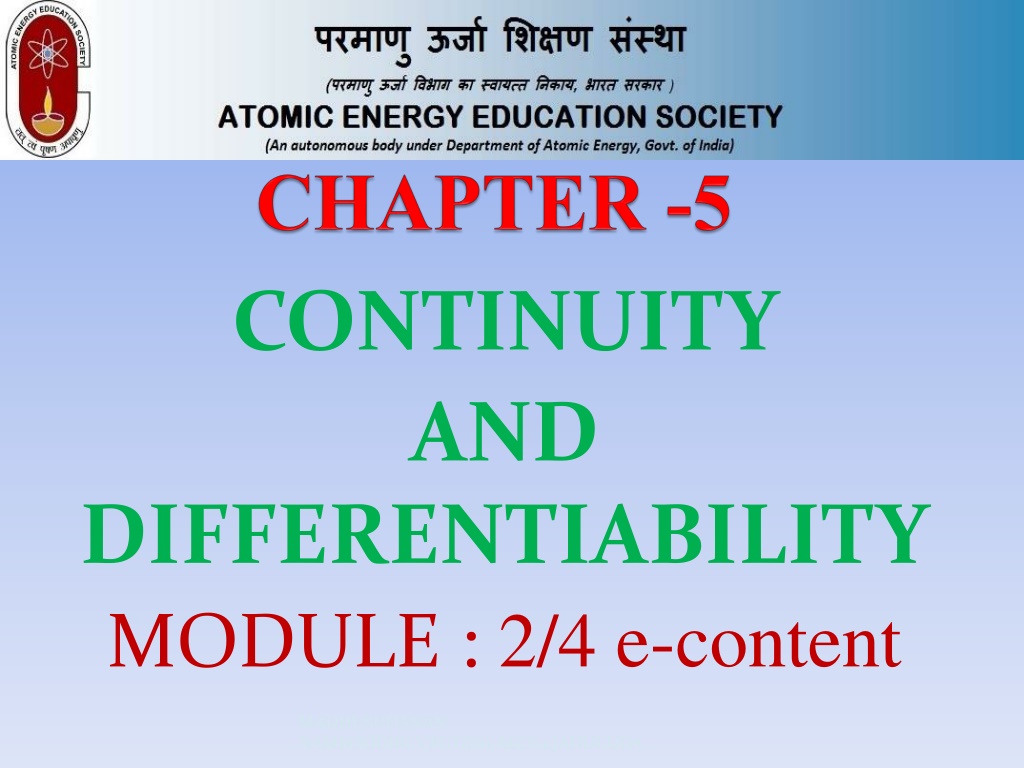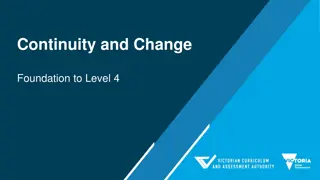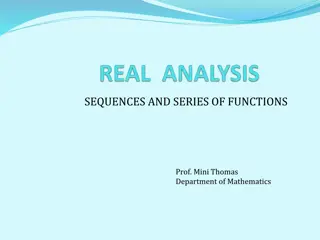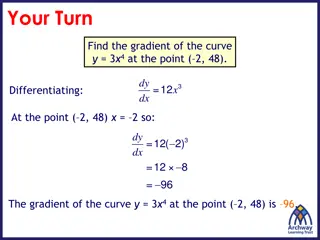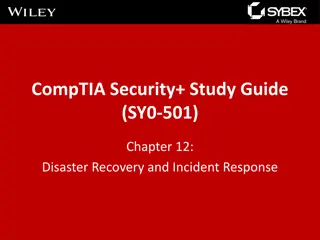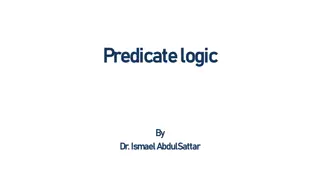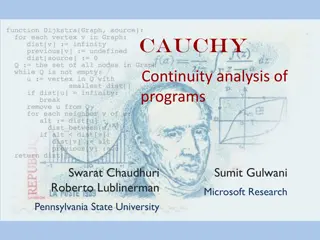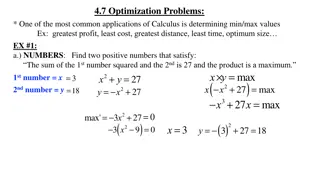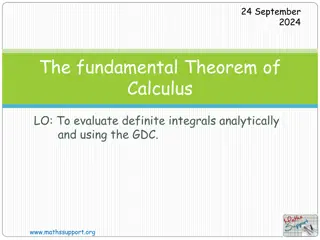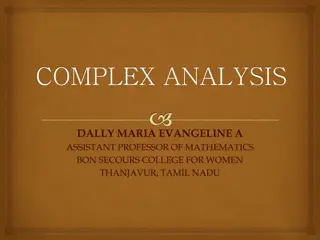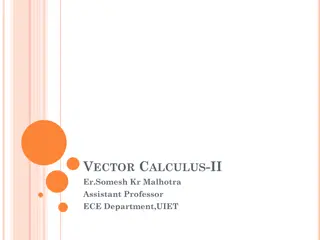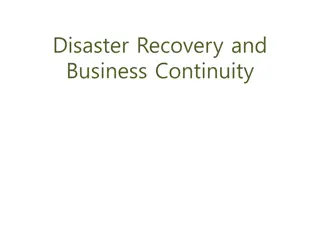Understanding Continuity and Differentiability in Calculus
This module covers the concepts of continuity and differentiability in calculus, including the definition of derivatives, differentiability criteria, the Chain Rule, and derivatives of implicit functions. The content discusses the relationship between continuity and differentiability, previous knowledge required, and practical examples to understand these mathematical principles.
Download Presentation

Please find below an Image/Link to download the presentation.
The content on the website is provided AS IS for your information and personal use only. It may not be sold, licensed, or shared on other websites without obtaining consent from the author. Download presentation by click this link. If you encounter any issues during the download, it is possible that the publisher has removed the file from their server.
E N D
Presentation Transcript
CONTINUITY AND DIFFERENTIABILITY MODULE : 2/4 e-content MADHUSUDANAN NAMBOODIRI.V,PGT(SS),AECS-1,JADUGUDA
PREVIOUS KNOWLEDGE Continuity of functions Evaluation of limit of functions Definition of differentiation Product rule and Quotient rule of differentiation MADHUSUDANAN NAMBOODIRI.V,PGT(SS),AECS-1,JADUGUDA
DIFFERENTIABILITY For a given function y = f(x) the derivative of f(x) is denoted by f (x) or y or ?? ??and is defined as ? ?+ ? ? f (x) = lim , provided the right hand 0 side limit exists. Derivative f(x) at a point in its domain ? ?+ ? ? is f (a) = lim . If this limit does not exists 0 then we say f(x) is not differentiable at x = a A function is said to be differentiable in an interval [a, b] if it is differentiable at every point of [a, b]. A function is said to be differentiable in an interval (a, b) if it is differentiable at every point of (a, b) MADHUSUDANAN NAMBOODIRI.V,PGT(SS),AECS-1,JADUGUDA
Theorem : If a function f is differentiable at a point c, then it is also continuous at that point. ie. Differentiability implies continuity But the converse is not true. Consider f(x) = ? , which is a continuous function. Let us check its differentiability at x = 0 = 1 ? 0+ ? 0 Here L.H.D = lim = lim 0 0 = 1 ? 0+ ? 0 R.H.D = lim = lim 0+ 0+ Hence left hand derivative is not equal to the right hand derivative. Hence it is not differentiable at x = 0 MADHUSUDANAN NAMBOODIRI.V,PGT(SS),AECS-1,JADUGUDA
CHAIN RULE ( FUNCTION OF FUNCTION RULE) Let us find the derivative of y = f(x) = ?3+ 13 Expanding this as a polynomial we get y = ?9+ 3?6+ 3?3+ 1. Differentiating w.r.to x we get ?? ??= 9?8+ 18?5+ 9?2= 9?2?6+ 2?3+ 1 ?? Now let us take t = ?3+ 1 then y = ?3 ie y is a function of t were t is a function of x. Since y is a function of t we can find ?? function of x we can find ?? ??. Here ?? ??= 9?2?3+ 12-------------(1) ?? and since t is ?? ??= 3?2---(3) ?? = 3?2= 3 ?3+ 12 (2) ??? MADHUSUDANAN NAMBOODIRI.V,PGT(SS),AECS-1,JADUGUDA
But from equation (1) ?? ??= 9?2?3+ 12 = 3 ?3+ 12 3?2 = ?? ?? from equations (2) and (3) When y is a function of t were t is a function of x then we can differentiate y w.r.to x and it is given by ?? ??=?? ?? Similarly if y = f(t) , t = ? and z = ? then we can ?? ?? ?? ?? ?? ?? ?? ?? ?? ?? find the derivative y w.r.to x and ?? ??=?? ?? ?? ?? ?? ?? This rule is called chain rule MADHUSUDANAN NAMBOODIRI.V,PGT(SS),AECS-1,JADUGUDA
DERIVATIVES OF IMPLICIT FUNCTIONS If in a function the dependent variable y can be explicitly written in terms of independent variable x i.e. in terms of 'x' must not involve y in any manner then the function is called an explicit function e.g. 1) y = x2+ 1 2) y = sin2x + cos 3x If the dependent variable y and independent variable x are so convoluted in an equation that y cannot be written explicitly as function of x then f(x) is said to be an implicit function. e.g. x2+ y2= tan-1xy. Steps used to find the derivative of Implicit functions MADHUSUDANAN NAMBOODIRI.V,PGT(SS),AECS-1,JADUGUDA
Step:1 Differentiate both the sides of the equation w.r.to x ( Independent variable) Step : 2 Use chain Rule Step :3 Use product rule , quotient rule ( if required) Step:4 Combined the ?? ?? terms and simplify Examples Q1.Differentiate ??? ? w.r.to x Solution: Let y = ??? ? 2 ??? ? ? ??? ? Using chain rule ?? 1 ??= ?? MADHUSUDANAN NAMBOODIRI.V,PGT(SS),AECS-1,JADUGUDA
2 ??? ? ???2? ? ? ?? ??= 1 ?? ?? ??= 1 1 2 ??? ? ???2? 2 ? ???2? ?? ??= 4 ? ??? ? OR Take y = ? where t = tan z and z = ? . Differentiating we get ?? ??= Using chain rule ?? 2 ?, ?? 1 ??= ???2? and ?? 1 ??= 2 ? ??=?? ?? ?? ?? ?? 1 1 2 ? ???2? ?? = 2 ? ???2? ?? 1 1 2 ???? ???2? ??= 2 ?= 4 ? ??? ? MADHUSUDANAN NAMBOODIRI.V,PGT(SS),AECS-1,JADUGUDA
Q2.If ??+ ??= ??+?prove that ?? ??= ?? ? Solution: Given ??+ ??= ??+? ---------(1) Differentiating both sides w.r.to x ? ????+ ??= ??+ ???? ??+ ???? ? ????+? ?? ?? ??= ??+? ??= ??+?+ ??+??? ?? ?? ?? ??= ?? ??= 1 + ?? ?? ??+?= ??+? ?? ??+? ?? ?? ??+?=??+?? ?? ?? ??= ?? ? ?? ?? ?? ( Using eq.(1) ) MADHUSUDANAN NAMBOODIRI.V,PGT(SS),AECS-1,JADUGUDA
SUMMARY A function f(x) is said to be differentiable at a point x = a if LHD at x =a = RHD at x = a Steps for finding he derivative of Implicit functions Step:1 Differentiate both the sides of the equation w.r.to x ( Independent variable) Step : 2 Use chain Rule Step :3 Use product rule , quotient rule ( if required) Step:4 Combined the ?? ?? terms and simplify MADHUSUDANAN NAMBOODIRI.V,PGT(SS),AECS-1,JADUGUDA
QUESTIONS FOR PARCTICE 1) Differentiate sin ( cos(xy)) w.r.to x 2) Differentiate ?? , x > 0 3) If ???2? + cos ?? = ? ,? ?? find the value of ?? ?? when x =1 and y = ? 4 4) Differentiate ???2?2 w.r.to x 5) Show that f(x) = 2x - ? is continuous but not differentiable at x = 0 6) Discuss the continuity and differentiability of the function f(x) = ? + ? 1 in the interval ( -1,2) MADHUSUDANAN NAMBOODIRI.V,PGT(SS),AECS-1,JADUGUDA
